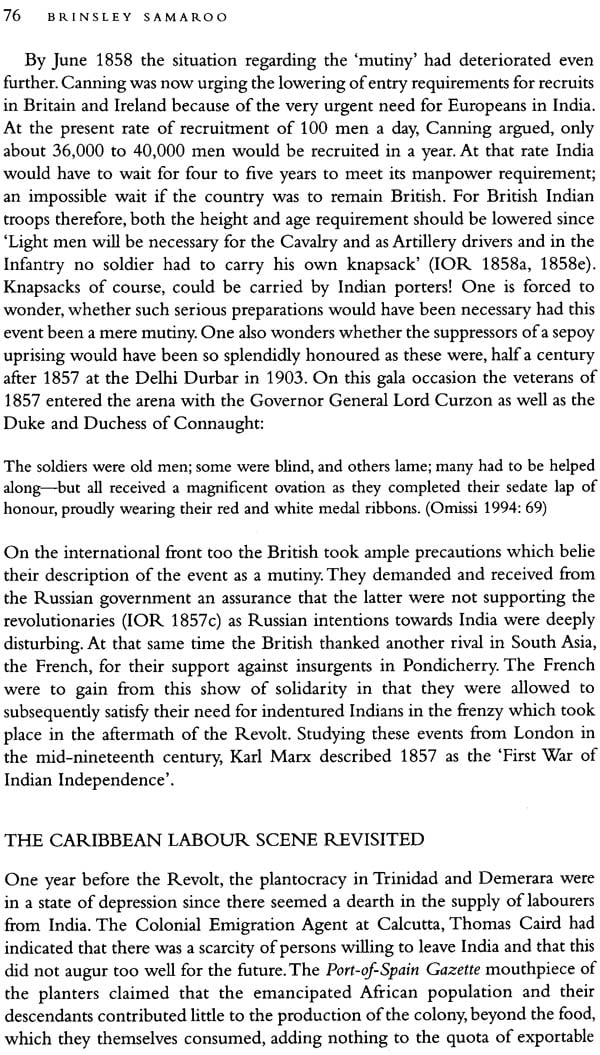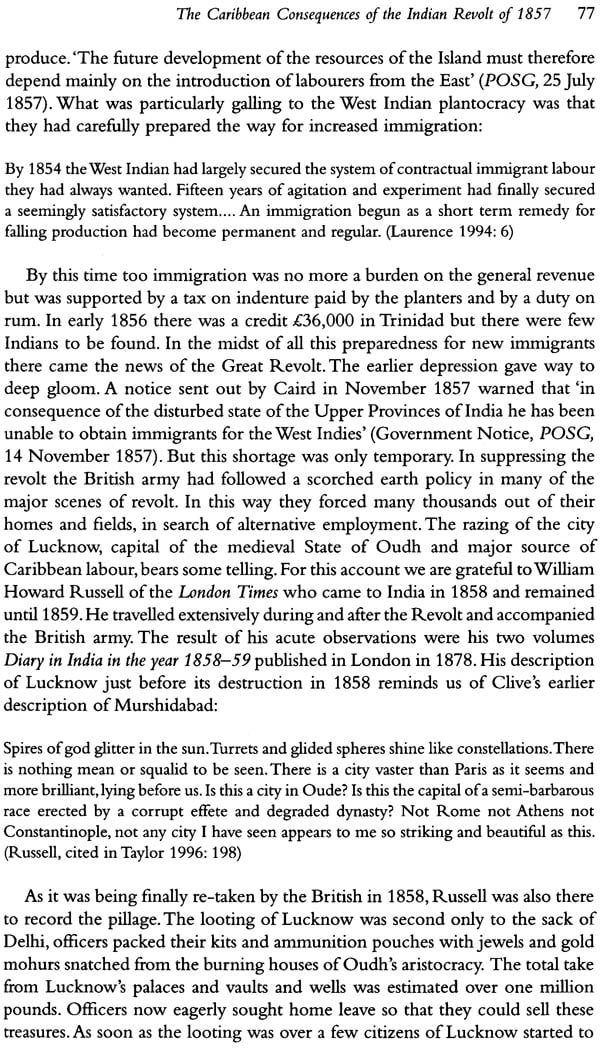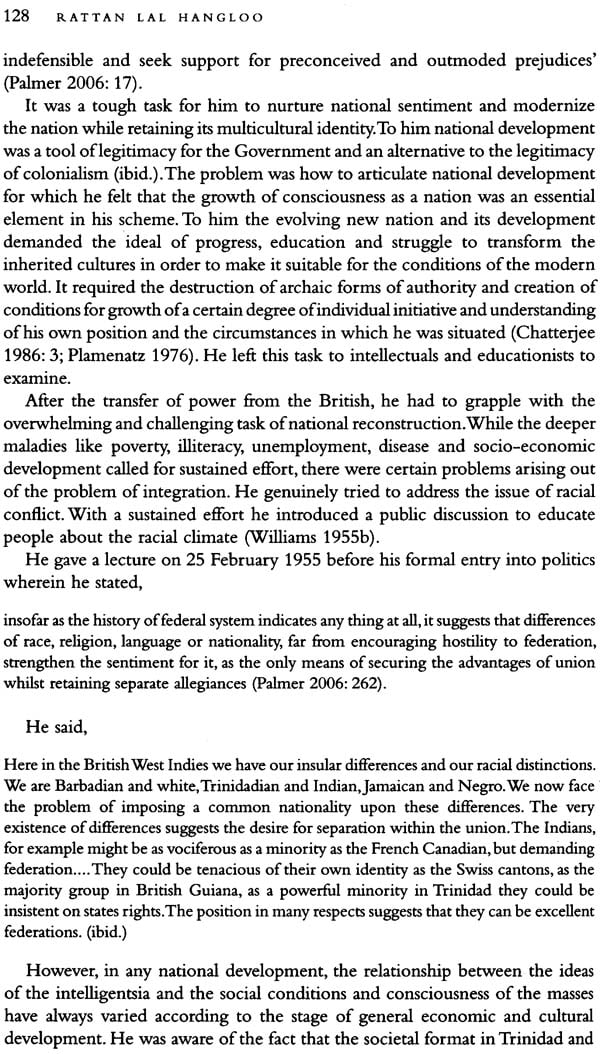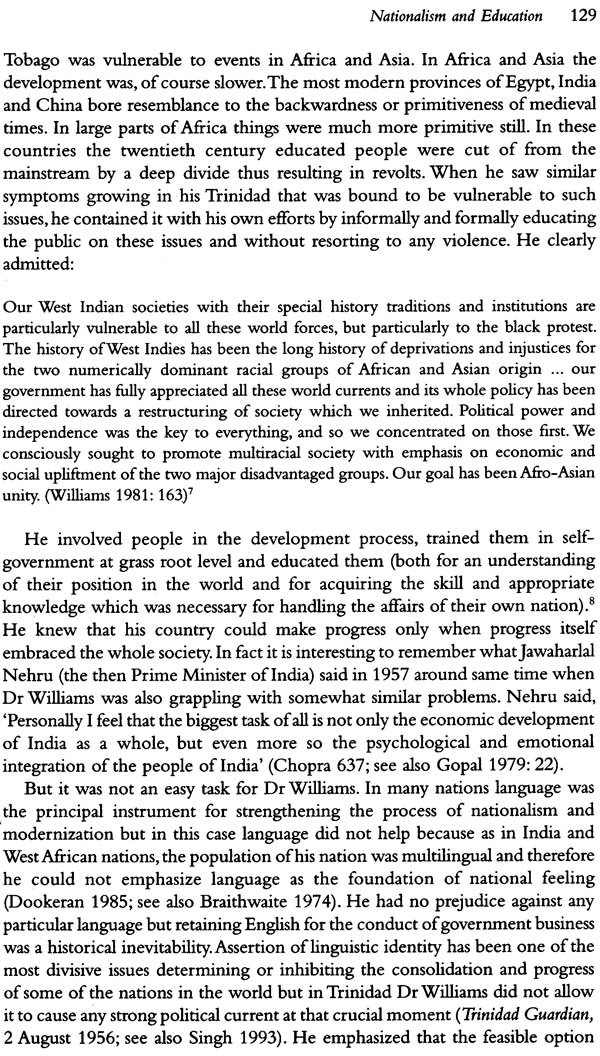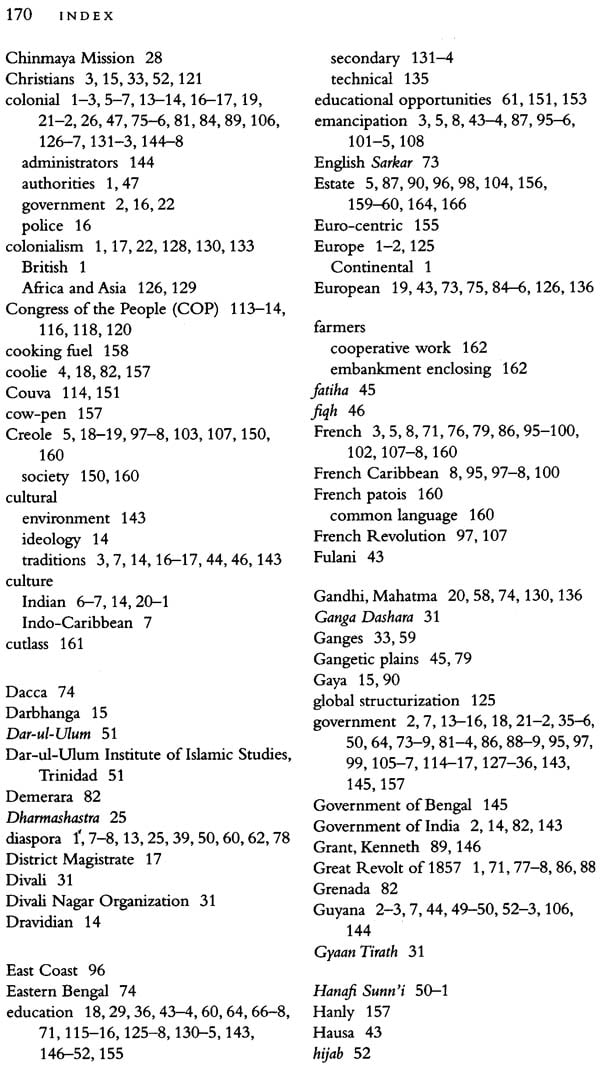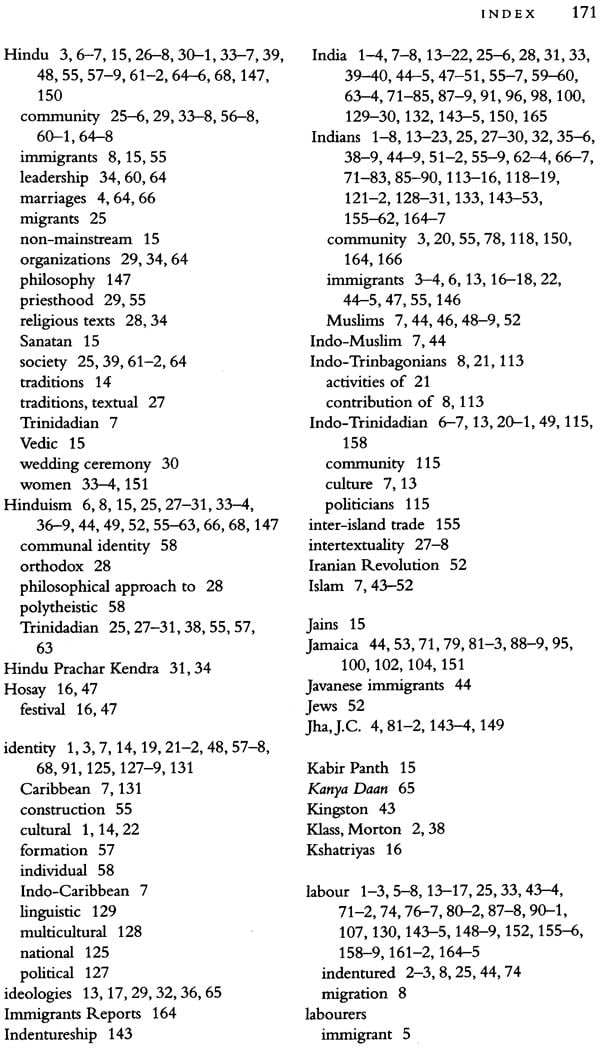
Indian Diaspora in the Caribbean (History, Culture and Identity)
Book Specification
| Item Code: | NAM035 |
| Author: | Rattan Lal Hangloo |
| Publisher: | Primus Books, Delhi |
| Language: | English |
| Edition: | 2015 |
| ISBN: | 9789384082383 |
| Pages: | 184 |
| Cover: | Paperback |
| Other Details | 9.5 inch x 6.5 inch |
| Weight | 310 gm |
Book Description
This collection of essays seeks to explore some aspects of the history of Indian emigration to the Caribbean, which is one of the most significant events in the history of Indian indentured migration that took place to different parts of the world during the second half of the nineteenth century. The Indians faced many hardships in the Caribbean during the initial stages of their migration. However, over the years, despite several adversities, Indian have become one of the most successful immigrant ethnic groups in the Caribbean. Their success in the fields of business, politics and education has allowed them to retain their ‘Indian’ cultural identity, strengthening their linkages with the homeland, i.e. India, as well as the Indian diaspora across the world.
Indian Diaspora in the Caribbean: History, Culture and Identity studies key facets of this retention of the Indian ethos. While doing so, it also analyses notions of religio-cultural transformation, identity reconstruction, political participation and transformations, as well as resistance to enslavement and other oppressions. It also examines the mobility and contribution of women and attempts to provide significant insights into the lives of Indian Muslims in the Caribbean.
The contributors to this volume, who are recognized scholars and academics in the field of Caribbean studies, also have the advantage of first-hand knowledge and the experience of being a part of the Indian diaspora in the Caribbean. The volume will be of significant interest to historians, sociologists, anthropologists and political scientists researching on the Indian diaspora.
Rattan Lal Hangloo is Vice-Chancellor, Kalyani University, West Bengal. He was Head, Chair of Indian Studies at Tbilisi State University, Georgia, and Professor of History at Hyderabad Central University. Earlier he served Hyderabad Central University as Head, Department of History and also Chief Proctor.
Professor Hangloo was earlier Dean, School of Global Relations & School of Languages, Literature & Culture, Central University of Punjab, Bathinda. He has also served as the Chair of Indian Studies at the University of West Indies, Trinidad and Tobago, and has been visiting professor at the University of Delaware (USA), University of Michigan (USA), Heidelberg University (Germany), Bamberg University (Germany), Ashkhabad University (Turkmenistan). and Maison des Sciences de I’Homme of Paris (FMSH) France. He has been awarded the Fulbright (USA) and DAAD Fellowships (Germany). He has published over 80 papers in national and international journals. His publications include Agrarian System of Kashmir (2000), and the edited volumes Situating Medieval Indian State (1995), Approaching Islam (2005), New Themes in Indian History Politics, Gender, Environment and Culture (2007), and History of Science and Technology in India: Exploring New Themes (2011).
This Book Attempts to explore the textures of Indian culture among people of Indian origin and the difficulties that they have and continue to encounter as diasporic communities. For the diaspora, debating socio-religious and cultural issues that are rooted in Indian soil is not only an intellectual necessity but also a strong identity-market, which could not be abandoned despite varied onslaughts on their religious and cultural values from time to time. The essays featuring in this volume will discuss some of these aspects. They point towards the need to adopt a rigorous approach to the study of the Indian diaspora in the Caribbean in a more comprehensive manner. This book also provides a useful lens for both the Government of India and the Indian diaspora, specifically in the Caribbean and, in general, across the world, through which to view the complexities of the problems of the Indian diaspora and the responses it requires.
The idea for Indian Diaspora in the Caribbean: History, Culture and Identity took shape while I was Chair of Indian Studies at the University of West Indies in Trinidad and Tobago. The interest in India expressed by my students, many of whom represented the fourth or fifth generation of the Indian diaspora, always amazed me. The manner in which images of Indian, that had been passed on from one generation to another in a variety of ways, unfolded before me, not only as observed among Indian students, but also among Africans and others who have been significantly influenced by these images, deserves a keen sense of appreciation and acknowledgement. Although the poverty of pre-independent India has been a strong construct that has remained with the Indian students, yet it has never overshadowed the Indian identity they proudly cherish. This idea of putting together essays based on our regular interactions with our students also appealed to some of my colleagues. Despite their engagements, they extended their support and I wish to express my deep sense of gratitude to all those who have contributed to this volume.
It is here that I must also acknowledge a deep debt of gratitude to Dr Karan Singh, the President and Shri Suresh K. Goel, Director General of the Indian Council for Cultural Relations (ICCR), Ministry of External Affairs, Government of India for their encouragement. Shri Sunil Mehdiretta, Director, Chairs Abroad, and Mr Sunil Kumar Singh, Programme Officer at ICCR, New Delhi have always been very helpful.
My special thanks also go to Shri J.S. Sapra, the then Indian High Commissioner to Trinidad and Tobago and the present High Commissioner, Shri Malay Mishra for their generous hospitality. I also thank Dr Winston Dukheran, the present Finance Minister of Trinidad and Tobago who met me personally at Hyderabad during his visit to Indian in the summer of 2010. I am grateful to Professor Kusha Haraksingh and his wife, Professor Indira Singh of the University of West Indies. I benefited immensely from the discussions I had with both of them. My thanks are also due to Dr Ajay Kumar Sahoo, of Centre for the study of Indian Diaspora, University of Hyderabad and for his useful suggestions during our interaction.
I would like to acknowledge the help of my colleagues at the Department of History, University of West Indies, particularly Professor Rita Pamberton, Dr Michel Toussaint, Dr Claudius Fergus, Dr Sherry-Ann Singh, Dr Basil Read, and Dr John Campbell.
Late Ashram Bhagirath Maharaj was a student and friend who familiarized me with the complexities of the Indian diasporic culture in the Caribbean. His enthusiasm and generosity will always be remembered. It is because of Ashram and his companion, Nalni, that exploring most of Trinidad and Tobago turned out to be a much looked-forward-to affair. My deepest thanks go to them. It pains me to know that Ashram will not be able to see this volume in print. My wonderful friends Khurshid Ganai, Professor Appa Rao Podile, Professor Ranjan Chakrabarti, Professor Sheela Prasad, Rajesh Raina, Dr Tanima Saha, Dr Srikumar, Professor Salma Ahmed Faruqi and Dr M.N. Rajesh deserve my special gratitude because they could always be counted upon to come up with solutions to my Problems. My thanks to Ms. Erica Williams, the daughter of Dr Eric Williams, the first Prime Minister of Trinidad and Tobago, Professor Dominic Shellard, Pro-Vice-Chancellor, International Affairs and Dr Jennifer Lavia, University of Sheffield for inviting me to deliver the Dr Eric Williams Memorial Lecture.
My thanks also go to Ms. Kimberly, Uta Ram Prasad, Radica Sukhraj, Indira, Anila Bagwat, Vede, his mother and the students whom I taught in the University of West Indies. I am grateful to Maria Peter Joseph, the then Secretary to the Department of History, University of West Indies, and her colleague Shallen for providing wonderful secretarial assistance.
My teacher, Professor Harbans Mukhia, also deserves my gratitude for his valuable ideas and new insights.
Special thanks to my family members, Shri M.L. Hangloo, Shri P.L. Hangloo, Dr Nanajee Hangloo and Arti, Suman, Sushma, Shri Jawaharlal Kaul, Professor O.N. Kaul, Phoola Kaual, Veena Kaul, Col. Ravi Bhat, Dolly, Rajinder Kaul and Rita Kaul, for their invaluable support and strength.
Finally, I am deeply grateful to my wife Sharika Kaul Hangloo and our children Arkaprateem and Dr Arkapravah for their special interest in my work; without them, this book would not have seen the light of day.
The Indian Diaspora constitutes an integral part of the socio-economic, political and cultural life in the Caribbean region. Having stemmed from the ugly policies and ambitious designs of British colonialism, Indians in the Caribbean have shared the suffering in a variety of ways since the beginning of their arrival on the islands (Vertovec 1992: 2). The first generation was not only the victim of poverty and inhuman treatment meted out to them at every level but also of getting uprooted from their soil in the most devastating manner that has ever been witnessed in the history of the Indian diaspora. However, since the middle of twentieth century, Indo-Caribbeans have come to play a much more active role in the mainstream cultural, commercial, and political life of their adopted countries (Manuel 1997/1998: 18).
Pushing more than half a million Indians to the Caribbean as indentured labourers with absolutely false hopes and promises was the worst sort of violation of human rights and dignity by the British colonial masters (Vertovec 1992: 3). Thousands of Indians who strongly protested against the British rule during the first War of Independence in 1857 also came to the Caribbean to escape persecution (see the article by Brinsley Samaroo 2008). Steven Vertovec (1992) has been very frank in admitting that various immigration schemes were tried by the colonial authorities, including the importation of workers from Madeira, continental Europe, West Africa and China. Yet none of the groups fulfilled the needs of planters, either due to costs of recruitment and transport, unreliability of work, or a simple inability to survive in a tropical climate (see also Waite 1982). From 1834, planters in Mauritius were relatively successful in importing contract labourers from India and their model soon spread to sugar plantations around the world. The pervasive framework of British colonial administration provided the infrastructure that was needed both in India and overseas, to create what was deemed a new system of slavery (Tinker 1974). Indian indentured emigration to the Caribbean was a product of uneven world capitalist development (Roopnarine 2009: 114). Given the costs of recruitment and transportation (often underwritten by local governments of the colonies dominated by sugar planters), indentured Indian migration was quickly accepted by local plantocracies as the most beneficial (profitable) solution to the post-indenture period (Vartovec 1995).
The procedure to recruit Indians was fairly straightforward but involved a hierarchy of emigration officials in India and in the Caribbean. In India, the government of India appointed Protectors of Emigration in most regions and districts to monitor and manage the system efficiently and effectively. The respective Caribbean colonial government appointed emigration agents, medical officers on the ground and on the transporting ships. The emigration agents then employed provincial and district subagents, licensed recruiters and local judges to supervise the judicial aspects of recruitment. In the Caribbean, each colonial government had an Immigration Department headed by a chief officer (called different names, Protector of Immigrants, Agent-General of Immigrants or Immigrant Agent-General). The chief immigration officer was assisted by other sub-immigration officers such as inspectors, clerks and interpreters. The Immigration Department was responsible for the distribution of Indians and the function of the indenture system. (Roopnarine 2009: 114).
Importation of Indian coolies came to be regarded as the economic salvation of a number of sugar producing colonies, British or others. Even though their arrival was considered economically fortunate, that was not the end of their problems, that continued to plague them generation after generation. Their new environment was predominantly Eurocentric, with traces of African values (MEA 2001: 196). The first batch of indentured labourers arrived in British Guyana on 5 May 1838 on two ships, the SS Hesperus and the SS Whitby. However, the migration was stopped for seven years and resumed with a batch of indentured labourer to Trinidad on 30 May 1845 aboard the Fath al Razak (Ramnarine 1998/1999). By the end of the nineteenth century, changing conditions in the Caribbean colonies, nationalist opposition in India and reformist government in Europe put an end to the indentured contracts (Eltis 2002: 205). Although the system of importing indentured labourers from the Indian subcontinent was abolished in 1920, by this time approximately 1, 43, 900 Indians were already brought to Trinidad (Niranjana 1998; Klass 1991), primarily to serve a specific tenure and then be fee after completing their obligations, which in most cases were agricultural. The last boat of indentured servants from India arrived in the Caribbean in 1917 (Vertovec 1992). By the time the indenture system ended officially, most workers had left the estates and settled near them in small, dispersed village communities (Khan 1994: 247). Morton Klass (1961) offers a good account of the social organization of the villages of the East Indian in Trinidad.
The majority of Indians who came to the Caribbean under different colonial governments (French, British and Dutch) originated from north India, primarily eastern Uttar Pradesh and western Bihar, with lesser numbers from south India, i.e. Andhra Pradesh and Tamil Nadu (Mahabir 2008). Although many of them returned to India after the abolition the indentured labourer system, the majority remained in the Caribbean, and their descendants now constitute the largest ethnic groups in Trinidad, Guyana, and Surinam, outnumbering their Afro-Caribbean compatriots, and accounting for about 20 per cent of the English-speaking West Indian population as a whole (Manuel 1997/1998: 18). The backgrounds of Indian immigrants to the Caribbean were rather diverse (van der Veer and Vertovec 1991: 150). N. Jayaram has provided the statistical details about the religious and caste backgrounds of Indian immigrants, drawing information from various sources:
Of the 91,691 emigrants, 78,772 (85.9%) were Hindus; 12,851 (14.0%) were Muslims; and 68 (0.1%) were Christians. Of the 78,772 Hindus emigrants, 13,242 (16.8%) were of ‘Brahman castes’; 5,988 (7.6%) were of ‘Artisan castes’; 27,680 (35.1%) were of ‘Agricultural castes’; and 31,862 (40.5%) were of ‘Low castes’... since the emigrants held several identities (regional, linguistic, occupational, etc., besides caste and sub-caste), all passing for caste, guessing which particular identity an indentured labourer invoked at the time of his or her recruitment is difficult. For example, ‘Ajoodhabasi’ (resident of Ayodhya), ‘Halwaye’ (maker of sweetmeats), and ‘Kessan’ (peasant) are mentioned as castes in Comins’ list. (2006: 146)
Apart from the caste and religious differences, there was also a consistent major disparity between the number of men and women contracted as indentured labourers. The scarcity of Indian women in the British Caribbean was to have a profound impact on the indentured immigrant Indian community and on the status and role of women in Indian-Caribbean society (Ramnarine 1998/1999: 11). According to Rhoda Reddock (1994) the required ratio of women to men changed at least six times from 1857 to 1879. It was only in later years of the indentured period that more women were recruited from India (MEA 2001: 196). There are several push factors that caused such a large number of Indians to decide to leave for the Caribbean thousands of miles away from their homeland.
With no respect for their socio-religious norms and pattern of family life and traditions, these Indian labourers were initially housed in the barracks vacated by the West African slaves, in the aftermath of Emancipation in the 60s of the twentieth century. Sometimes labourers were allowed to cultivate a small patch of land or keep a cow or pig; but despite this and the rationing of food, vitamin deficiency plagued the estates, as did malaria and hookworm (Vertovec 1995: 60). Indo-Caribbeans felt unprecedentedly isolated and, in many cases, even more consciously committed to maintaining their cultural heritage (Manuel 1997/1998: 18). Women played an important role in continuing to keep the cultural traditions of the homeland alive.
Just as women in India sing wedding songs that are central to folksong, traditions, Indian women in the Caribbean are seen as the preservers of tradition with regard to music and dance of wedding rituals in particular. A common view is that it is due to women maintaining these Indian traditions that enabled a popular genre like chutney to develop. (Ramnarine 1998/1999: 12)
J.C. Jha has very rightly observed:
The Indian immigrants would have been quite familiar with the old Indian institution of extended family. However, there were several factors in the indenture days militating against a good family life. First the method of recruitment was faulty; the recruiters wanted to earn money and gave a false picture of the conditions of the country to which the Indians were emigrating and therefore many left their family behind. The women the Indians were emigrating and therefore many left their family behind. The women in any case were not willing to emigrate in large numbers. Some adventurous people also left India for a distant land to start a family afresh. It was only in later years of the indenture period that steps were taken to recruit whole families and sometimes from the same area. Even then the privacy of a normal family life was gone in depots and later in boats. Moreover, the dwelling conditions in the barracks were bad the immigrants were thrown together without any consideration for privacy. Naturally enough, there were conflicts and sex crimes. Also Muslim marriages before 1930s and Hindu marriages before 1946 were not recognized by Trinidad and Tobago law. (1985: 20)
The majority of Indian immigrants who settled in the Caribbean after the end of indentured contracts have permanently changed the cultural mixture of these societies (Look Lai 1993). After their arrival contact with Africans did not take place in an atmosphere of mutual goodwill. Although the Indians did not meet with any hostile reception, there was extreme timidity and no overwhelming displays of friendship on either sides. Very rarely did not Africans—the so—called natives at that time—behave spontaneously. The remarkable absence of conflict between the two could be attributed to the fact that initially both the races were not concerned to defend the personal claims to land and property. On first making contact with Indians the Africans generally refrained from aggressive behaviour but so long as the indentureship lasted the Africans did despise the Indians. The two did not mix, they lived in uneasy but non-violent co-existence (Brereton 1985: 30). According to Bates (1912: 83), both had a comfortable sense of superiority, the Negro because he is free to loaf while the coolie is indentured for five years, the coolie because of his traditions of his ancient civilization and the pride of caste. Although mostly the Indians behaved peacefully at the beginning of their contacts with the African people, they had not relinquished their claim to superiority. After landing there they took care to maintain certain traditions and festivities of the homeland. This was also to indicate the superiority of their cultural heritage. The sources are too. fragmentary to permit a generalization but gradually the language of expression and gesture could overcome cultural barriers.
The reasons for transformation of contact into collision must often have been complex; they can seldom be reconstructed precisely from the Trinidad Indian accounts which are strongly partisan in such matters. However there were two main reasons for conflict: either the members of Afro-culture sensed a threat to their property and their accustomed way of life or they had ceased to respect and trust the Europeans. The entirely Indo-centric manner in which the Indians interpreted their encounters with other cultures is apparent from their failure to judge the consequences of their appearances or realize how fragile the trust to the natives to Africans was.
| Preface | vii | |
| Note on Editor and Contributors | ix | |
| Introdution | 1 | |
| 1 | Indian' Culture in Trinidad: Transportation, Reconstruction and Integration, 1845-1970 | 13 |
| 2 | The Ramayana in Trinidad: A Socio-Historical Perspective | 25 |
| 3 | Muslims in the Caribbean | 43 |
| 4 | Trinidad Hinduism, 1917-1945: Religion Transformation and Identity Construction | 55 |
| 5 | The Caribbean Consequences of the Indian Revolt of 1857 | 71 |
| 6 | Resistance to Enslavement and Oppression in Trinidad, 1802-1849 | 95 |
| 7 | General Elections of 2007 in Trinidad and Tobago: The Indian Factor in the People's National Movement | 113 |
| 8 | Nationalism and Education: Dr Eric Williams' Vision for Trinidad and Tobago | 125 |
| 9 | Breaking the Glass Ceiling: East Indian Women and Educational Mobility in Trinidad and Tobago | 143 |
| 10 | Market and Field: The Workplace of the Indian Women in Trinidad, 1900-1940 | 155 |
| Index | 169 |


